
Mary of Bethany is a biblical figure mentioned only by name in the Gospel of John in the Christian New Testament. Together with her siblings Lazarus and Martha, she is described by John as living in the village of Bethany, a small village in Judaea to the south of the Mount of Olives near Jerusalem.

Mark 16 is the final chapter of the Gospel of Mark in the New Testament of the Christian Bible. It begins after the sabbath, with Mary Magdalene, Mary the mother of James, and Salome bringing spices to the tomb to anoint Jesus body. There they encounter the stone rolled away, the tomb open, and a young man dressed in white who announces the resurrection of Jesus (16:1-6). The two oldest manuscripts of Mark 16 conclude with verse 8, which ends with the women fleeing from the empty tomb, and saying "nothing to anyone, because they were too frightened".

The empty tomb is the Christian tradition that women coming to the tomb of Jesus on the third day after his crucifixion found it empty. The story is found in all four gospels, but beyond this basic outline they agree on little. However, the whole death, burial, and resurrection narrative predates the gospels and Paul's letters via oral traditions. The gospel authors' usage of standard literary, historical, and biographical compositional practices of their day along with their use of multiple sources account for much of the differences, which were usually over peripheral details. Mark's Gospel, in its original ending, the women who discover the tomb flee, telling no one, after meeting a young man who he tells them that Jesus will meet the disciples in Galilee; Matthew introduces guards and a curious doublet whereby the women are told twice, by angels and then by Jesus, that he will meet the disciples in Galilee; Luke changes Mark's one "young man" to two, adds Peter's inspection of the tomb, and deletes the promise that Jesus would meet his disciples in Galilee; John reduces the women to the solitary Mary Magdalene and introduces the "beloved disciple" who visits the tomb with Peter and is the first to understand its significance.

The life of Jesus in the New Testament is primarily outlined in the four canonical gospels, which includes his genealogy and nativity, public ministry, passion, prophecy, resurrection and ascension. Other parts of the New Testament – such as the Pauline epistles which were likely written within 20 to 30 years of each other, and which include references to key episodes in Jesus' life, such as the Last Supper, and the Acts of the Apostles, which includes more references to the Ascension episode than the canonical gospels - also expound upon the life of Jesus. In addition to these biblical texts, there are extra-biblical texts that Christians believe make reference to certain events in the life of Jesus, such as Josephus on Jesus and Tacitus on Christ.
John 20 is the twentieth chapter of the Gospel of John in the New Testament. It relates the story of Jesus' resurrection. It relates how Mary Magdalene went to the tomb of Jesus and found it empty. Jesus appears to her and speaks of his resurrection and dispatches Mary to tell the news to the disciples. Jesus then appears to his disciples. The events related in John 20 are described somewhat differently in Matthew 28, Mark 16, and Luke 24.
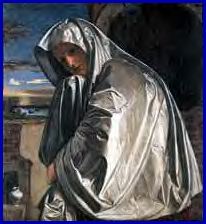
John 20:11 is the eleventh verse of the twentieth chapter of the Gospel of John in the New Testament of the Christian Bible.
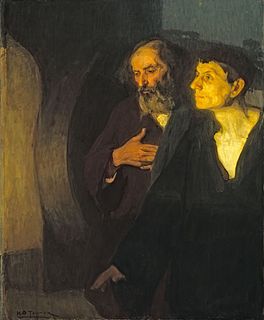
John 20:9 is the ninth verse of the twentieth chapter of the Gospel of John in the Bible. Peter and the Beloved Disciple have been examining Jesus' empty tomb and the arrangement of the grave clothes. John 20:8 states that the Beloved Disciple looked in the tomb and believed, though there is conflict on what exactly he believed. John 20:9 seems to modify this statement but its exact meaning is also unclear.

John 20:8 is the eighth verse of the twentieth chapter of the Gospel of John in the New Testament of the Christian Bible. Peter and the Beloved Disciple are examining Jesus's empty tomb. Peter has been inside the tomb since John 20:6, while the Beloved Disciple had been examining it from outside. In this verse the Beloved Disciple enters the tomb.
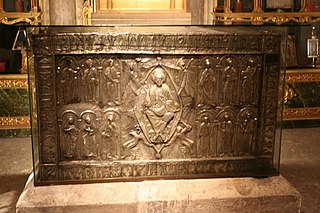
John 20:7 is the seventh verse of the twentieth chapter of the Gospel of John in the Bible. In this verse, Peter is standing in Jesus' empty tomb. The Beloved Disciple and perhaps Mary Magdalene are outside. This verse describes the arrangement of the grave clothes they see.

John 20:16 is the sixteenth verse in the twentieth chapter of the Gospel of John in the New Testament of the Bible. The verse describes the moment that Mary Magdalene realizes that Jesus has returned from the dead, when she recognizes his voice calling her name
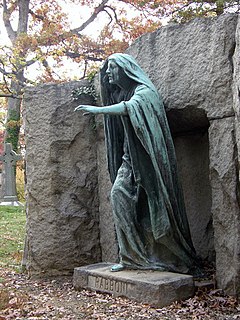
John 20:2 is the second verse of the twentieth chapter of the Gospel of John in the New Testament. Mary Magdalene has just discovered that the tomb of Jesus has been opened. In this verse she seeks out and tells this news to Peter and the "disciple whom Jesus loved".

John 20:3–4 are the third and fourth verses of the twentieth chapter of the Gospel of John in the New Testament. Peter and the Beloved Disciple have been informed by Mary Magdalene that Jesus' tomb has been opened and in these verses they depart for the tomb.

John 20:1 is the first verse of the twentieth chapter of the Gospel of John in the New Testament. John 20 covers the resurrection of Jesus after his crucifixion. In this verse Mary Magdalene visits Jesus' tomb and finds it opened.

The stolen body hypothesis posits that the body of Jesus Christ was stolen from his burial place. His tomb was found empty not because he was resurrected, but because the body had been hidden somewhere else by the apostles or unknown persons. Both the stolen body hypothesis and the debate over it presume the basic historicity of the gospel accounts of the tomb discovery. The stolen body hypothesis finds the idea that the body was not in the tomb plausible – such a claim could be checked if early Christians made it – but considers it more likely that early Christians had been misled into believing the resurrection by the theft of Jesus's body.

Matthew 28 is the twenty-eighth and final chapter of the Gospel of Matthew in the New Testament. This chapter records that Jesus is risen, describes the actions of the first witnesses to this event, and ends with the Great Commission.
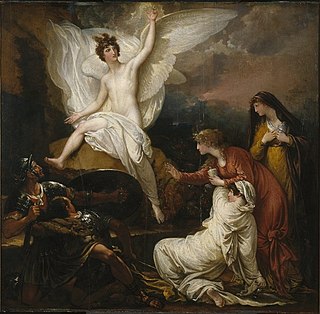
Matthew 28:2 is the second verse of the twenty-eighth chapter of the Gospel of Matthew in the New Testament. This verse is part of the resurrection narrative. Mary Magdalene and "the other Mary" were approaching Jesus' tomb after the crucifixion, when an earthquake occurred and an angel appeared.

Matthew 28:7 is the seventh verse of the twenty-eighth chapter of the Gospel of Matthew in the New Testament. This verse is part of the resurrection narrative. An angel has appeared at the empty tomb and in this verse he continues his instructions to Mary Magdalene and "the other Mary".

Matthew 28:8 is the eighth verse of the twenty-eighth chapter of the Gospel of Matthew in the New Testament. This verse is part of the resurrection narrative. Mary Magdalene and "the other Mary" had just encountered an angel who has appeared at the empty tomb of Jesus, and in this verse they leave to bear the angel's message.

Matthew 28:9 is the ninth verse of the twenty-eighth chapter of the Gospel of Matthew in the New Testament. This verse is part of the resurrection narrative. Mary Magdalene and "the other Mary" are leaving the empty tomb of Jesus after encountering an angel, and in this verse they encounter the risen Jesus.

Matthew 28:10 is the tenth verse of the twenty-eighth chapter in the Gospel of Matthew in the New Testament. This verse is part of the resurrection narrative. Having left the empty tomb, Mary Magdalene and "the other Mary" are on their way to meet the other disciples, when Jesus meets with them. In this verse the risen Jesus speaks with them.



















